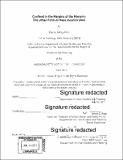| dc.contributor.advisor | Brent D. Ryan. | en_US |
| dc.contributor.author | Kim, Elaine Minjy | en_US |
| dc.contributor.other | Massachusetts Institute of Technology. Department of Urban Studies and Planning. | en_US |
| dc.date.accessioned | 2017-09-15T15:32:07Z | |
| dc.date.available | 2017-09-15T15:32:07Z | |
| dc.date.copyright | 2017 | en_US |
| dc.date.issued | 2017 | en_US |
| dc.identifier.uri | http://hdl.handle.net/1721.1/111391 | |
| dc.description | Thesis: M.C.P., Massachusetts Institute of Technology, Department of Urban Studies and Planning, 2017. | en_US |
| dc.description | Cataloged from PDF version of thesis. | en_US |
| dc.description | Includes bibliographical references (pages 152-156). | en_US |
| dc.description.abstract | The historically unprecedented and internationally incomparable rate of incarceration in the United States merits an analysis of the prison as a key political, social, economic, and physical institution in America. This research sits in the gap in the existing literature between sociological research on incarceration and architectural studies of the conditions of confinement by turning my attention to urban design scale physical characteristics and their interaction with their context. It begins with the premise that the characteristics of the prison as a physical structure are entangled with the prison as cultural item, political tactic, and social concept. I ask: what is the urban form of mass incarceration? The question is investigated by focusing on a sample of 45 federal correctional complexes. Each complex is measured according to five different metrics through the use of spatial data to address three scales of concern: regional, city, and site. To address the regional scale concern of incarcerated populations being placed far from their home communities and barriers to maintaining social connections, I measure each complex's proximity to an urbanized area and accessibility to transit. I study the city scale concern of facilities being relegated to the remote and ignored margins by considering measures of visibility: distance to the nearest major road, and the number of nearby points of interest that may bring people within proximity of the prison. To investigate the building scale concern of the generous amounts of space correctional facilities demand, I compare the complex's size to the size of the hosting city. I find that correctional complexes are not well sited or designed to address the issues associated with all three scales. Analyzing the variation among the complexes, the results show that the facilities built during the rapid rise of incarceration share similar physical characteristics. Interpreting raw measures using metric-appropriate checkpoints, I find that even the complexes that are more integrated relative to others are in reality isolated and disconnected. Looking at the public comments and design descriptions for the facilities among the highest ranking and lowest ranking sites, I find that the design intention is to blend the facility into the rural landscape, and that the ability of residents to "forget that it's even there" is seen as a design success and benefit. | en_US |
| dc.description.statementofresponsibility | by Elaine Minjy Kim. | en_US |
| dc.format.extent | 156 pages | en_US |
| dc.language.iso | eng | en_US |
| dc.publisher | Massachusetts Institute of Technology | en_US |
| dc.rights | MIT theses are protected by copyright. They may be viewed, downloaded, or printed from this source but further reproduction or distribution in any format is prohibited without written permission. | en_US |
| dc.rights.uri | http://dspace.mit.edu/handle/1721.1/7582 | en_US |
| dc.subject | Urban Studies and Planning. | en_US |
| dc.title | Confined in the margins of the margins : the urban form of mass incarceration | en_US |
| dc.title.alternative | Urban form of mass incarceration | en_US |
| dc.type | Thesis | en_US |
| dc.description.degree | M.C.P. | en_US |
| dc.contributor.department | Massachusetts Institute of Technology. Department of Urban Studies and Planning | |
| dc.identifier.oclc | 1003291785 | en_US |

